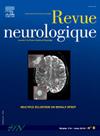可逆性脑血管收缩综合征(RCVS)初期弥漫性脑血管舒张。
IF 2.3
4区 医学
Q2 CLINICAL NEUROLOGY
引用次数: 0
摘要
背景与目的:可逆性脑血管收缩综合征(RCVS)以反复发作的雷击性头痛和脑动脉节段性血管收缩为特征,在3个月内消退。然而,文献中的两个病例报告显示,在RCVS的早期阶段,弥漫性脑血管扩张而不是血管收缩(Kobayashi, 2016;Oikawa et al., 2017)。本研究旨在报道RCVS初期弥漫性脑血管舒张的发生情况,分析弥漫性脑血管舒张患者的临床及预后特点。材料和方法:回顾性收集医学档案中的RCVS患者。比较初始和随访血管成像,评估初始血管造影中威利斯肌圈各节段的血管舒张和收缩情况。弥漫性血管舒张定义为前循环和后循环中四个或更多威利斯动脉圈的扩张,没有先前描述的脑动脉“串珠状”外观。根据有无弥漫性脑血管扩张将患者分为两组进行比较。结果:148例RCVS患者中,45例(30%)出现弥漫性脑血管舒张。弥漫性血管舒张发生在RCVS早期(雷暴性头痛发作至首次显像的平均延迟时间为2.25天对7.63天,P=0.047),主要影响脑大动脉第一段和第二段。与远端血管收缩相关(44.44%比25.24%,P=0.033)。弥漫性脑血管舒张患者发生出血的风险更高(蛛网膜下腔出血15.56% vs 3.88%, P=0.035;颅内出血为8.89%比0.97% (P=0.03)。血管舒张在女性中更为常见(71.11%比41.75%,P=0.001)。次要形式的RCVS与弥漫性血管扩张相关(51%对27%,P=0.008)。结论:早期脑血管造影可显示RCVS患者弥漫性脑血管扩张。在RCVS中,血管扩张可能具有病理生理意义,对患者具有临床和预后后果。本文章由计算机程序翻译,如有差异,请以英文原文为准。

Diffuse cerebral vasodilatation at the initial stage of reversible cerebral vasoconstriction syndrome (RCVS)
Background and purpose
Reversible cerebral vasoconstriction syndrome (RCVS) is characterized by recurrent thunderclap headaches and segmental vasoconstriction of cerebral arteries resolutive within three months. However, two case reports in the literature revealed diffuse cerebral vasodilatation rather than vasoconstriction at the early phase of RCVS (Kobayashi, 2016; Oikawa et al., 2017). This study aims at reporting the occurrence of diffuse cerebral vasodilatation at the initial stage of RCVS and at analyzing the clinical and prognostic characteristics of patients with diffuse vasodilatation.
Materials and methods
Patients with RCVS were retrospectively gathered from medical files. Initial and follow-up vascular imaging were compared to assess vasodilatation and vasoconstriction for each segment of the circle of Willis on the initial angiogram. Diffuse vasodilatation was defined as dilatation of four or more of the circle of Willis arteries both in the anterior and posterior circulations, without previously described “string of beads” appearance of cerebral arteries. Patients were split into two groups based on the presence of diffuse cerebrovascular dilatation for comparison.
Results
Among 148 patients with RCVS, 45 patients (30%) had diffuse cerebral vasodilatation. Diffuse vasodilatation was proved to occur at the early phase of RCVS (mean delay between thunderclap headache onset and initial imaging of 2.25 days versus 7.63 days, P = 0.047) and mainly affected the first and second segments of major cerebral arteries. It was significatively associated with distal vasoconstriction (44.44% versus 25.24%, P = 0.033). Patients with diffuse cerebral vasodilatation had a greater risk of hemorrhage (15.56% for subarachnoid hemorrhage versus 3.88%, P = 0.035; 8.89% for intracranial hemorrhage versus 0.97%, P = 0.03). Vasodilatation was more frequent in women (71.11% versus 41.75%, P = 0.001). Secondary forms of RCVS were associated with diffuse vasodilatation (51% versus 27%, P = 0.008).
Conclusion
The early cerebral angiogram may reveal diffuse cerebrovascular dilatation in patients with RCVS. Vasodilatation might have a pathophysiological implication in RCVS with clinical and prognostic consequences for patients.
求助全文
通过发布文献求助,成功后即可免费获取论文全文。
去求助
来源期刊

Revue neurologique
医学-临床神经学
CiteScore
4.80
自引率
0.00%
发文量
598
审稿时长
55 days
期刊介绍:
The first issue of the Revue Neurologique, featuring an original article by Jean-Martin Charcot, was published on February 28th, 1893. Six years later, the French Society of Neurology (SFN) adopted this journal as its official publication in the year of its foundation, 1899.
The Revue Neurologique was published throughout the 20th century without interruption and is indexed in all international databases (including Current Contents, Pubmed, Scopus). Ten annual issues provide original peer-reviewed clinical and research articles, and review articles giving up-to-date insights in all areas of neurology. The Revue Neurologique also publishes guidelines and recommendations.
The Revue Neurologique publishes original articles, brief reports, general reviews, editorials, and letters to the editor as well as correspondence concerning articles previously published in the journal in the correspondence column.
 求助内容:
求助内容: 应助结果提醒方式:
应助结果提醒方式:


